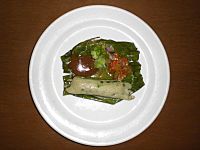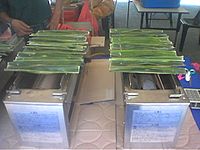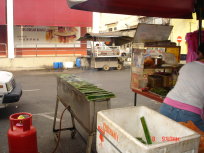Otak-otak facts for kids

Otak-otak served in Jakarta
|
|
| Alternative names | Otah |
|---|---|
| Place of origin | Indonesia |
| Region or state | South Sumatra |
| Associated national cuisine | Indonesia Malaysia, Singapore |
| Main ingredients | Fish, spices, leaves |
Otak-otak is a yummy fish cake from Southeast Asia. Its name means "brains" in Malay and Indonesian. This is because the original dish looked a bit like brain matter. It is made from mashed fish mixed with different spices. This tasty mix is then wrapped in a leaf parcel.
Otak-otak is usually cooked by steaming or grilling. It stays inside its leaf wrapper while cooking. You can eat it as a snack all by itself. Or, you can enjoy it with steamed rice as part of a meal. The first otak-otak likely came from Palembang cuisine in South Sumatra. There, it was grilled in banana leaf parcels. It had mashed fish, tapioca starch, and spices.
You can find different kinds of otak-otak all over Indonesia and other Southeast Asian countries. Some versions might not look much like the Palembang one. In Singapore and southern Malaysia, the otak-otak is often reddish-orange or brown. This color comes from chili, turmeric, and other spices.
Contents
Where Otak-otak Comes From

Otak-otak is very popular on both sides of the Strait of Malacca. Many believe this dish is a mix of Malay (especially from Palembang) and Peranakan cooking styles. In Indonesia, the name "otak-otak" comes from how the Palembang version looks. It is whitish-grey, soft, and a bit squishy, like brain matter.
From Palembang, this dish is thought to have spread. It traveled to the islands of Sumatra and Java. It also reached the rest of the Malay Peninsula. Three Indonesian cities are famous for their otak-otak: Palembang, Jakarta, and Makassar. On Bangka Island, the town of Belinyu is well-known for making a lot of otak-otak.
The town of Muar in Johor, Malaysia, is also famous for its otak-otak. It is a special food that brings tourists from nearby states and Singapore. In Singapore, people often call this dish otah.
What's Inside Otak-otak?
Otak-otak is made by mixing fish paste with different spices. The type of fish used can change depending on the place. In Malaysia, mackerel is often used. In Indonesia, ikan tenggiri (which is a type of wahoo) is a popular choice. Other fish like bandeng (milkfish) or the more expensive ikan belida (featherback fish) can also be used.
In Indonesia, the mix usually has fish paste, shallots, garlic, scallions, egg, coconut milk, and sago or tapioca starch. In Jakarta, you can often find otak-otak sold from small stalls. These stalls are often near bus stops, especially when people are going home from work. In Makassar, the main fish used is fresh king mackerel.
In Malaysia, the mix usually includes fish paste, chili peppers, garlic, shallots, turmeric, lemon grass, and coconut milk. This mixture is then wrapped in a leaf. People use banana, coconut, or nipa palm leaves. The leaves are softened by steaming first. Then, the wrapped otak-otak is either grilled or steamed.
Different Kinds of Otak-otak
There are many kinds of otak-otak from different places. While it is usually made with fish, some newer versions use crab or prawn meat. You can even find some made with fish head!
In Indonesia, otak-otak is often linked to Palembang, South Sumatra. But other parts of Indonesia also have popular otak-otak recipes. These include Jakarta and Makassar. In Palembang, people eat otak-otak with cuko. This is a sweet, sour, and spicy vinegar sauce. On Bangka Belitung islands, the cuko sauce is a bit different. It is made with vinegar, shrimp paste, and fermented soybean paste. In Jakarta and Makassar, people enjoy otak-otak with a spicy peanut sauce.
The otak-otak from southern Peninsular Malaysia and Singapore is wrapped thinly. It uses banana or coconut leaves. Then, it is grilled over a charcoal fire. This makes it drier and gives it a smoky fish smell. Most Indonesian otak-otak is pale white. But the Malaysian and Singaporean versions are reddish-orange. This color comes from chili paste, and they are often very spicy.
Muar-style otak-otak is wrapped inside attap (Nipa palm) leaves. It is clipped at both ends with a stapler or toothpick. Then, it is grilled or roasted. While fish otak-otak is most common, Muar-style can also be made with prawns, cuttlefish, crab meat, fish head, or even chicken. Besides being wrapped and grilled, Muar-style otak-otak can also be steamed.
Peranakan-style otak-otak (also called otak-otak Nyonya) comes from Penang in northern Malaysia. It is made with mashed fish, eggs, and herbs. This mix is wrapped in banana leaf and then steamed.
Foods Like Otak-otak
There are other tasty dishes similar to otak-otak. From the Malaysian state of Terengganu, there is a dish called sata. An Indonesian dish that also uses banana leaf is called pepes. Other similar foods include pais ikan and botok. These are also fish paste dishes cooked in banana leaves.
In the northern Philippine province of Pangasinan, there is a similar treat called tupig. It is cooked like otak-otak, but tupig is sweet. It is made from a thick batter of glutinous rice flour, coconut strips, coconut milk, sugar, and nuts. This batter is wrapped in banana leaves and then grilled over coals.
See also
 In Spanish: Otak-otak para niños
In Spanish: Otak-otak para niños





